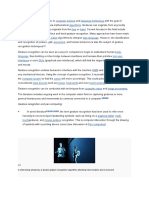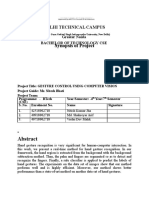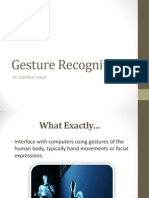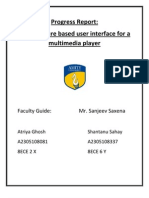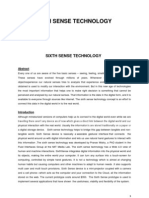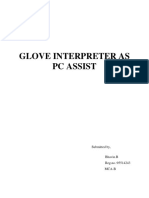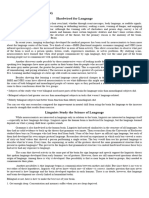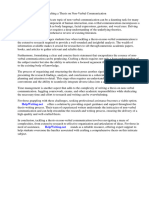CS4731 Project: Gesture Recognition
CS4731 Project: Gesture Recognition
Uploaded by
Ritish TalwarCopyright:
Available Formats
CS4731 Project: Gesture Recognition
CS4731 Project: Gesture Recognition
Uploaded by
Ritish TalwarOriginal Title
Copyright
Available Formats
Share this document
Did you find this document useful?
Is this content inappropriate?
Copyright:
Available Formats
CS4731 Project: Gesture Recognition
CS4731 Project: Gesture Recognition
Uploaded by
Ritish TalwarCopyright:
Available Formats
CS4731 Project: Gesture Recognition
Hart Lambur Department of Computer Science Columbia University hal2001@columbia.edu Blake Shaw Department of Computer Science Columbia University bs2018@columbia.edu
December 21, 2004
1
1.1
Introduction
The Idea
The user interface (UI) of the personal computer has evolved from a text-based command line to a graphical interface with keyboard and mouse inputs. Undoubtedly, human-computer interaction will continue to evolve towards more natural forms of input, like human movement recognition. Popular culture has long viewed computer vision and visual gesture recognition as one of the future ways we will interact with our computers; indeed, many high-end 3D environments already use some form of human movement recognition in their user interfaces. In our project, we explore the feasibility of implementing a simple system to understand a basic set of hand gestures. Our main interest is exploring the computer vision techniques involved in real-time tracking of visual input and the analysis of that input to recognize gestures. In the most general sense, recognizing gestures seems to be an extremely complex task. A sophisticated gesture recognition system would have to incorporate many complex algorithms spanning many elds of computer science as well as incorporate an abundance of knowledge about the nature of human movement. Building a robust system which could recognize a large set of motions is a very compelling problem, but implementing this kind of system is currently not feasible for a semester long project. However, by dening a limited vocabulary of gestures, we can create a compact system which can effectively recognizes this set of simple gestures. In our system, the user controls a well-dened visual 1
input (in our case, a bright thimble of LEDs worn on the index nger) to perform certain basic computer tasks. Simple left/right/up/down gestures are recognized under variable light conditions with little or no operator training; using this simple four gesture vocabulary, basic computer functions can be controlled. Below, we give a brief outline of some of our initial project goals before discussing the details of our user interface and implementation.
1.2
Initial Project Goals
Realizing the broad reach of our gesture recognition project across many disciplines and elds of research, we carefully documented our project goals during the planning phase. Below we outline what we attempted to accomplish, and what we has been successfully implemented. i. Tracking user input: Initially, we needed to track the real-time position of the user input. Using a selfconstructed LED nger-light, we were able to track the position of the users nger under varying light conditions. By constraining the environment to search for a single, neon-green-colored LED object in an otherwise average-intensity scene, we have been able to achieve accurate results using simple techniques. ii. Gestures in a direction: To recognize our basic four gesture vocabulary, we implemented an algorithm to recognize user movements in the left/right/up/down directions. This task required us to take into account the speed at which the gesture is made in order to differentiate between deliberate actions and general random movement. By keeping track of the last N points of the users path,
CS4731 Project: Gesture Recognition
we analyze this point list for strong movements in a direction by averaging the local distance between points. We compute these averages in both the x and y directions separately and, using a threshold corresponding to gesturespeed, we determine the general direction of a swift movement. iii. Holding gestures: As an extension to our basic gesture vocabulary, we extended our system to recognize holding gesturesthe visual equivalent to holding down a mouse button. This problem is more complicated than simply recognizing the user swiping in a direction. It involves recognizing a fast movement in a direction and gauging if the user remains a certain distance away from some sort of relative center which, when the user returns to, constitutes releasing the button. Our system denes the relative center on a gesture-by-gesture basis, considering the center to be the initial starting location of the movement. Establishing a robust method for tracking this relative center and holding motion was one of the more challenging aspects of the project.
Figure 1: The Apple iSight webcam used in our vision system. For gesture recognition, the iSight is particularly wellsuited since it sits on top of the users monitor, at eye level. By placing the camera directly in front of the user, motions can be directed at the computer screen rather than at some off-axis camera, allowing for a more intuitive interface.
User Interface
Developing an interface through which one can control a computer with simple hand gestures is not an easy task. iv. Recognizing other motions: There are innumerable People have grown accustomed to using well dened inextensions to our gesture recognition system that would put devices to interact with computersdevices such as enhance our gesture vocabulary. Ideas include matching the keyboard and mouse easily capture user input in a well gestures to actions using shapes (like drawing a circle understood fashion. Designing a computer system to recin the air), or recognizing sequences/patterns of simple ognize hand movements presents difcult problems, both up/down/left/right motions. This was one aspect of the in developing the algorithms to handle such a task, and in project which we were unable to spend much time devel- developing an intuitive interface through which users can oping. interact naturally with the system. We designed our interface around two basic hardware components: the Apple iSight webcam, and a light v. Integrating system with computer: The nal step of our project connected the gesture recognition system to glove/wand. After a quick overview of this hardware, we basic functions of the computer. We developed a back- comment on the general setup of our user interface, and end to execute simple shell and apple scripts to control some of the problems we have encountered while designa variety of computer applications using decisions from ing an intelligent, intuitive system to recognize hand gesour gesture recognition system. Our scripting framework tures. allows for extreme exibility in developing new applications for the system. Currently, we can control the func- 2.1 Computer Hardware tions of an MP3 player (play/pause/volume/track selection), and surf web pages (using back/forward/link se- As the eyes of our vision system, we use the Apple iSight lections commands) with our basic gesture vocabulary. digital webcam to capture a real-time video feed (see gFuture applications include basic video game control for ure ??). The iSight is a beautifully designed webcam ideMario Brothers (or an equivalent game), and scrolling ally suited to our gesture recognition system. The camthrough text applications. eras fast auto-focus and auto-exposure allow sharp im-
CS4731 Project: Gesture Recognition
2.2
Dening a Relative Center
In an effort to keep our gesture recognition system as natural to use as possible, we wanted to ensure that the users motions could be recognized at any position within the cameras eld of view, and not just in the center of the video frame. To do this, we developed a concept of a relative center, to allow the user to make gestures starting from any place inside the frame of the video feed. In our system, the relative center is dened as the position from which the users hand must move a certain amount within a given time frame for the hand motion to be recognized as a gesture. By changing the time and speed that the users hand must move away from this center, the sensitivity of the system to user movements (that are not intended to be gestures) can be adjusted. To provide the user with some visual feedback for their Figure 2: The four LED thimble attached to a users index nmotions, the relative center position of the user is shown ger. The four LEDs are splayed to distribute the light intensity over a range of angles. This allows a bright light to be seen by in real-time overlaid on top of the video feed. The curthe camera no matter what orientation the user prefers to keep rent center position is drawn on top of the image with a their nger. standard cross-hair target; furthermore, the outer circle of the cross-hair denes how far the user must move from the center position (within a certain time frame) to trigger an action. It is also important to note that the video image is mirrored when displayed to the user, creating a ages to be captured at a high frame rates, a feature that more natural environment for the user to observe his or has provided indispensable when attempting to track fast her interaction with the vision system. gesture motions of the user. Furthermore, the camera is specically designed to sit on top of the computer monitor, positioning the lens at eye level directly in front of the user, and not off-center on a desk like many other 2.3 Gesture Recognition webcams. By positioning the camera directly in front of the user, making gestures is more natural, and the user is For our basic system, we implemented a simple vocabugiven the impression that he or she is interacting directly lary of four gestures: left, right, up and down. Given our with the computer monitor and not with some distant cam- relative center, this left/right/up/down motions are recognized when the user moves outsider the outer circle of the era. center cross-hair within a given time. Details of the algoIn an effort to improve the robustness of the system, rithmic solution to this problem are discussed below. The system is calibrated so that slow, wandering hand we designed a light glove/wand which the user can use to interact with the gesture recognition system. We soldered movements are not recognized as gestures. These types four bright green LEDs together and attached them to a of movements are slow enough to not move outside the 9V battery pack. Figure ?? shows the LED nger-thimble specied motion distance within the specied time. By attached to the users index nger. Holding the battery allowing the user to move his or her hand freely up to a pack in the palm of his or her hand, the user can then reasonable threshold, the system is robust to false posipoint with their index nger and have the vision system tives, motions that were not intended to be recognized as track the bright green LEDs for gesture recognition. gestures.
CS4731 Project: Gesture Recognition
Figure 3: Two screenshots of the system tracking holding gestures. Blakes index nger is tracked using the cross-hair as seen
above. When a quick motion is made, the system remembers the relative center from which the motion originated, and freezes that position with the green holding circle. As long as Blake keeps his nger outside the green holding radius, the action is held and the cross-hair displays the direction of the action in red. When Blake brings his nger back inside the green circle, the holding gesture is turned off.
2.4
Holding Gestures
As a nal element to our user interface, we extended our basic four gesture vocabulary to recognize holding gestures. In essence, we designed our UI to differentiate between quick movements outside the relative center and back, and slow movements that are held away from the relative center. We gauge the initial fast movement away from the center in the same way as beforegestures outside a specied distance within a give time frame are recognized as actionsbut the system checks to see if the movement is held away from the center for a given time interval following the quick action. The UI provides the the user with some visual feedback if they are holding a gesture. If the user quickly moves outside the outer circle of the cross-hair triggering a fast motion, but maintains his position there for longer than a half second or so, the cross-hair turns red and HOLDING is displayed in the top right corner of the display (see gure ??). The relative center cross-hair from before the users initial quick action is frozen on the display, and the holding action will not be released until the user moves back within the holding radius of the frozen cen-
ter. With this visual information, holding gestures become a natural extension to the standard left/right/up/down motions, and a new user is quickly able to learn how to use holding gestures.
Implementation
The implementation for our gesture-recognition system is divided into six main areas: building the light source to track, capturing video, tracking the path of the light source, recognizing gestures from path analysis, displaying the graphical interface, and executing scripts upon completion of gestures. Figure ?? shows an outline of our code structure.
3.1
Building the Light Source
There are many considerations for picking an object to track, because we want to nd an easy means by which we can distinguish the object from the background under a variety of lighting conditions. Initially we simply tracked a green highlighter, using its distinct color to iden-
CS4731 Project: Gesture Recognition
PathTracker DIR_THRESH DIST_THRESH GREEN_BLUE_THRESHOLD GREEN_THRESHOLD HOLD_COUNTER_SIZE HOLDING_RADIUS PATH_SIZE SEARCH_RADIUS TRACK_OBJECT_SIZE XSIZE YSIZE path missedFind lastMovement lastFoundPoint isMotion isHolding holdingPoint holdCounter createAndShowGUI() printPath() scanPath() thresholdPixel() updateTracker() main()
We decided to use the Apple iSight webcam as the hardware for our video capture system. For software, we use a Java Class called VideoCapture which simplies the Quicktime library routines for grabbing each frame Figure 4: A class diagram for projects Java implementation. The main PathTracker class calls VideoCapture to grab images of video as it is read from the iSight. We obtained the from the iSight camera and uses VideoArea to draw the pro- basic framework for the VideoCapture class from the incessed images back on the display using Javas Swing libraries. ternet and then modied it for our own purposes (see references). From the VideoCapture class, we obtain each frame as a Raster object which we then wrap into tify it. There are not many every day objects that are a BufferedImage. This setup allows for easy access to bright green, so this was an adequate choice. However, in pixels of each frame. order to make our system more robust to different backgrounds and lighting conditions, we decided to use four 3.3 Tracking the Path of the Light Source green LEDs attached to the users nger (see gure ??). The green LEDs are easy to identify because their red and For each frame we scan through every pixel and detergreen intensities are registered by the camera as almost mine if the pixel is part of the light source or not. We immaxed out, allowing us to pick a high threshold. Further- plement this by checking if the red and green components more, the blue channel is approximately 20% less bright of the pixels color are above a specic threshold. Also then the red and green channels. We use this fact to distin- we make sure that the difference between the green changuish the green LEDs from other bright lights. We found nel and the blue channel is above a certain threshold; this the LED system seems to be quite robust, working in a blue-green test allows us to pick out the light source from variety of visual environments including those containing other non-green bright light sources in the scene. We sum green objects. up the x and y positions for each pixel found to be part of
VideoCapture height width image raster dispose() getHeight() getWidth() getNextImage() getNextRaster()
Figure 5: We constructed an LED nger thimble out of four
VideoArea controller currentFrame VideoArea() draw() getPreferredSize() paintComponent()
green LED lights. The LEDs are solder together in a serial circuit and connected to a 9V battery pack.
3.2
Capturing Video
CS4731 Project: Gesture Recognition
the light source and keep a count of how many of these pixels have been found. If this count is above a certain threshold, we consider the light-source to be in the scene, and we calculate its position using the average of the x and y components for each pixel found to be part of the light source. For each frame we then register the position of the light source in a global path list, which keeps track of the last N positions of the light source found in the last N frames.
3.4
Path Analysis for Gesture Recognition
3.3.1
Tracking Optimization
We recognized that scanning every pixel of every frame was not necessarily needed to effectively nd the light source in the scene. By assuming a certain amount of locality of the users movement, we can simply search a small window around the users last know position. However, if the light source is not found within this small window, a ag is marked, and on the next pass, the entire frame is scanned in order to ensure that the light source is no where in the frame. Figure ?? shows an example of tracking the light source with the localize search window.
We analyze this global path list of positions of the light source over the last N frames to determine if a gesture has been made. The algorithm rst computes the average distance between all points on the list, if this average distance is greater then a certain threshold, there must have been a swift movement, and therefore we recognize that a gesture has taken place (see gure ??). The algorithm then considers the sum of the differences between the points in both the x and y components. If the sum of the differences of the x components of all points on the path is greater then sum of the differences of the y components, we can determine the motion to be in the x direction, and vice versa. By looking at the sign of the sum of the differences we can distinguish up from down, and left from right movements. We do further analysis with regard to the gesture equivalent of holding a button versus simply pressing a button. When the initial movement is made, the last point on the global path list is marked as a special return point. After the initial movement, the user has a certain number of frames to return the light-source to within a certain holding radius of this return point, in order to register pressing the button. Otherwise, if the user remains outside a certain radius of the return point, the system recognizes this as a holding gesture until the user nally returns to within the holding radius of the return point.
3.5
Displaying the Graphical Interface
We chose to use the Java Swing library for displaying the graphics and interface for our system. For each frame we draw the BufferedImage coming from the video feed to the screen, and then overlay a variety of visual aids. We draw a cross hair around the current position of the light source (see gure ??). When a motion is made in Figure 6: Here we see the search window used for our tracking a specic direction, that portion of the cross-hair is coloptimization overlaid on the video display. If the light source is ored red; when the user executes a holding gesture, the not found by searching this smaller area, the entire video frame HOLDING is printed on the screen. Furthermore, when is searched in the next iteration. a decision is made about the direction of the gesture, that decision is printed on the screen (left, right, up, down).
CS4731 Project: Gesture Recognition
5, 10
5, 35
Figure 8: Here we see images of the common elements used in
7, 55
our UI design. The cross-hair on the left shows the users current position, while the green return circle on the right is used to mark the relative center when holding a gesture.
4, 90
Conclusion and Discussion
Producing a gesture recognition system robust to different users under different lighting conditions is not an easy task. Real-time processing in computer vision is hard! 5, 123 Developing a responsive, usable system took considerable effort. However, we are very satised with our results. By imposing intelligent and meaningful limits on the visual environment, and by developing an intuitive user interface, we were able to create a simple yet robust gesture Figure 7: The above diagram shows the path analysis for path- recognition system. Below, we outline our project sucsize = 5. In this example, distance counter registers as 113.243 cesses and failures and discuss the current state-of-the-art based on the sum of the distances between these 5 points. Since in gesture recognition. distance counter > DIST THRESH, an action is triggered in the
specied direction (here the gesture is down).
4.1 3.6 Executing Scripts upon Completion of Gestures
Project Successes and Failures
Upon recognizing that a gesture has taken place, the system uses a Java Process object combined with the Mac OS X command line utility osascript to execute Applescripts on the host machine. These scripts are dened in external les, and can be easily modied for a variety of applications. Furthermore these scripts can simulate basic keyboard commands applicable to all applications running.
Simple algorithms and techniques proved to work best when trying to build a usable vision system that works in real-time. Since real-time video processing demands considerable CPU power, we needed to impose intelligent limits on the visual environment that would simplify our algorithmic complexity. We established two such limits: we required the user to wear an LED thimble, and we limited our gesture set to movements in the four cardinal directions. The initial problem of tracking a visual input, like a light wand, is easily done in a setting without time constraints, but this problem quickly becomes computationally intractable at 30 frames per second. To reduce the CPU power needed to nd an object in the video stream,
CS4731 Project: Gesture Recognition
we require the user to wear the green LED thimble, giving us a unique, bright light source to search for. The unusual neon green color allows us to nd and track the LEDs in a single pass through the images pixels using nothing more than a simple threshold search technique. Attempting to deduce inputs from a user wildly moving his or her nger all over the screen is impossible, even with the most complicated and robust of gesture recognition systems. But detecting gestures becomes tractable when the vocabulary is limited in some meaningful way. We recognize gestures in the four cardinal directions. Our simple path tracking algorithm deduces movements by analyzing a list of past positions and determining if the user has moved a certain threshold in a certain direction within a given time limit. The simplicity of the system allows for robust recognition of simple gestures for different users and different style of motionwith little or no effort a new operator can become comfortable with the controls without the algorithm having to adapt to the new users input style. This robustness is not common in more complicated environments; given the noise common to human motion (such as the swaying of a users hand), recognizing more than a few simple gestures demands new techniques to learn a specic users style of input. We were quite happy to nd that our simple path tracking algorithm was fast, responsive and robust to different users motions. With the pervasive use of personal computers in modern society, nearly everyone has an understanding of how keyboards and mice provide input to a GUI. However, gesture recognition is not common. Few people have interacted with their computers by pointing with their ngers or simply waving their hands. This means that an intelligent user interface design is crucial to building a gesture recognition system that can be quickly understood by new users. We feel that we successfully implemented such an interface. The video feed is mirrored to the user, and a bright cross-hair is displayed over the LED thimble. When a quick motion is made, a holding circle showing the relative center from which this motion originated is displayed, giving the user visual input to decide if they want to hold the gesture. When combined with robust gesture recognition, this intelligent user interface allows new operators to become experts in the system quickly and effortlessly. For all our project successes, we encountered our share
of disappointments. Despite our best attempts to limit the algorithmic complexity of our recognition system, the software is computationally intensive, and only offers smooth video when a small frame size is used. Furthermore, there is a short lag time between the users motions and the video display; while this lag is small, is can be aggravating to a user who repeats several motions thinking the rst one was not recognized. Some of these performance issues likely stem from our use of the Java programming language. It is reasonable to assume that native C implementations may result in improved performance, allowing for smoother, larger video display with little lag.
4.2
Future Directions
Building a simple gesture recognition system was a pedagogically rewarding and instructive experience (and a lot of fun). But we still feel we only touched the tip of the iceberg. Below we list some of possible extensions of our project: i. Multiple Gestures: We limited our gesture vocabulary to a simple set of four gestures, but there are many interesting applications that involve more gestures and motions. ii. Two or more light systems: Putting LEDs on multiple ngers would allow for many more motions and types of motion to be detected. LEDs on the thumb and index nger would allow users to make rotational movements that could, among other things, scroll through documents/windows, or zoom in and out of images. iii. Tracking without LEDs: The most useful hand gesture recognition system wouldnt require the use of an LED glove or light wand. Accurately tracking the position of a users ngers is an exceptionally difcult problem, however, and requires much more complicated machine learning algorithms to recognize ngers under varying light conditions. iv. Recognizing hand posture: Besides tracking the position of a users ngers, much information can be deduced from a users hand posture. Developing a system to recognize if the user is holding out their palm (to stop a program, for example), or is holding a clenched st would be useful in building a true vision-based computer interface.
CS4731 Project: Gesture Recognition
Current state-of-the-art research focuses around psycholinguistic studies that describe a philology of gestures. Researchers have categorized hand movements into conversational gestures, controlling gestures, manipulative gestures, and communicative gestures in an effort to better distinguish and interpret our hand motions. Sign language, an important and highly structured form of communicative gestures, has been an obvious focus. More complicated algorithms using statistical machine learning techniques, like Bayesian networks and Hidden Markov Models have been used to semantically model meaningful human movements, with good results. These current efforts have produced far more complicated systems then we have implemented, being able to recognize movements without the visual limitations we have imposed, and point to a future where visual gesture recognition will be as pervasive as todays keyboard and mouse.
CS4731 Project: Gesture Recognition
10
A
A.1
Code Listing
gures/PathTracker.java
javax.swing.*; java.awt.*; java.awt.image.*; java.awt.geom.AffineTransform; java.util.Vector;
import import import import import
public class PathTracker{ private static final int XSIZE = 160; private static final int YSIZE = XSIZE*3/4; private static final int PATH_SIZE = 5; private private private private private private private private static static static static static static static static final final final final final final final final int int int int int int int int GREEN_THRESHOLD = 240; GREEN_BLUE_THRESHOLD = 80; TRACK_OBJECT_SIZE = 6; HOLD_COUNTER_SIZE = 9; DIR_THRES = 50; DIST_THRES = 10*PATH_SIZE; HOLDING_RADIUS = 25; SEARCH_RADIUS = 25;
private static String APP_NAME = "scripts/safari"; private private private private private private private private String lastMovement = null; boolean isHolding = false; boolean isMotion = false; Point holdingPoint; int holdCounter; Vector path = new Vector(); //Current Path boolean missedFind = true; Point lastFoundPoint = new Point(XSIZE/2, YSIZE/2);
public int thresholdPixel(BufferedImage image, int x, int y){ int blueGreenNum, greenNum; Color c = new Color(image.getRGB(x,y)); greenNum = c.getGreen(); blueGreenNum = greenNum - c.getBlue(); if (greenNum > GREEN_THRESHOLD && blueGreenNum > GREEN_BLUE_THRESHOLD) return 1; else return 0; }
CS4731 Project: Gesture Recognition
11
public Point findObject(BufferedImage image) { int l; int area = 0, posX = 0, posY = 0; double aveX = 0, aveY = 0; Color c; if(!missedFind){ for (int y=lastFoundPoint.y - SEARCH_RADIUS; y<lastFoundPoint.y + SEARCH_RADIUS; y++){ for (int x=lastFoundPoint.x - SEARCH_RADIUS; x<lastFoundPoint.x + SEARCH_RADIUS; x++){ if(x > 0 && x < image.getWidth() && y > 0 && y < image.getHeight()){ l = thresholdPixel(image, x, y); if(l != 0){ //gather area and positions of each objects area++; posX += x; posY += y; } } } } } else { for (int y=0; y<image.getHeight(); y++){ for (int x=0; x<image.getWidth(); x++){ l = thresholdPixel(image, x, y); if(l != 0){ //gather area and positions of each objects area++; posX += x; posY += y; } } } } aveX = (double)posX/area; aveY = (double)posY/area; Point newP; if(area > TRACK_OBJECT_SIZE){ newP = new Point((int)Math.floor(aveX), (int)Math.floor(aveY)); lastFoundPoint = newP; missedFind = false; return newP; } else {
CS4731 Project: Gesture Recognition
12
lastFoundPoint = new Point((int)Math.round(XSIZE/2), (int)Math.round(YSIZE/2)); missedFind = true; //System.out.println("MISSED TRACKING..."); return null; } } public void printPath(){ Point p; System.out.println("Path:"); for(int i=0; i<path.size(); i++){ System.out.println("(" + ((Point)path.get(i)).x + ", " + ((Point)path.get(i)).y + ")"); } } public String scanPath() { Point p1, p2; double distanceCounter = 0; double xDirectionCounter = 0, yDirectionCounter = 0; double slope; String movement = null; String decision = null; for(int i=0; i<path.size()-1; i++){ p1 = (Point)path.get(i); p2 = (Point)path.get(i+1); distanceCounter += Math.sqrt(Math.pow(p1.x - p2.x, 2) + Math.pow(p1.y - p2.y, 2)); xDirectionCounter += (p1.x - p2.x); yDirectionCounter += (p1.y - p2.y); } if(distanceCounter > DIST_THRES){ if(Math.abs(xDirectionCounter) > Math.abs(yDirectionCounter)) { //Movement is more horizontal if(xDirectionCounter < 0){ movement = "Right"; } else { movement = "Left"; } } else { // movement is more vertical if(yDirectionCounter > 0){ movement = "Up"; } else {
CS4731 Project: Gesture Recognition
13
movement = "Down"; } } } if(isMotion){ boolean insideHoldRadius = false; Point curPoint = (Point)path.lastElement(); if(Math.sqrt(Math.pow(holdingPoint.x - curPoint.x, 2) + Math.pow(holdingPoint.y - curPoint.y, 2)) < HOLDING_RADIUS) insideHoldRadius = true; if(insideHoldRadius){ isMotion = false; isHolding = false; decision = lastMovement; lastMovement = null; path = new Vector(); } else if(--holdCounter <= 0) { isHolding = true; decision = lastMovement; } } else if(isHolding == false && movement != null && !movement.equals(lastMovement)){ System.out.println(movement + " movement started:\t" + "Position is [" + xDirectionCounter + "," + yDirectionCounter + "]\t" + "Average Dist is " + distanceCounter/path.size()); isMotion = true; holdingPoint = (Point)path.get(0); holdCounter = HOLD_COUNTER_SIZE; lastMovement = movement; } return decision; } public String updateTracker(Point p) { if(p != null) { path.add(p); if(path.size() > PATH_SIZE){ path.removeElementAt(0); } return scanPath();
CS4731 Project: Gesture Recognition
14
} return null; } /** * Create the GUI and show it. For thread safety, * this method should be invoked from the * event-dispatching thread. */ private void createAndShowGUI() { //Make sure we have nice window decorations. JFrame.setDefaultLookAndFeelDecorated(true); //Create and set up the window. JFrame frame = new JFrame("Path Tracker"); frame.setDefaultCloseOperation(JFrame.EXIT_ON_CLOSE); //Set up the content pane. VideoArea videoArea = new VideoArea( this ); frame.getContentPane().add(videoArea); //Display the window. frame.pack(); frame.setVisible(true); while(true) { videoArea.draw(); } } public static void main(String[] args) { //Schedule a job for the event-dispatching thread: //creating and showing this applications GUI. javax.swing.SwingUtilities.invokeLater(new Runnable() { public void run() { PathTracker controller = new PathTracker(); controller.createAndShowGUI(); } }); System.out.println( "Exited SwingUtilities.invokeLater()" ); } public static class VideoArea extends JComponent { private static final int DOT_RADIUS = 3; private static final int XHAIR_LENGTH = 20;
CS4731 Project: Gesture Recognition
15
private static final int XHAIR_RADIUS = 20; private VideoCapture vc; private PathTracker controller; private BufferedImage currentFrame = new BufferedImage(XSIZE, YSIZE, BufferedImage.TYPE_INT_RGB); private static Process process; private static boolean runScript = true; public VideoArea(PathTracker controller) { this.controller = controller; try { vc = new VideoCapture(XSIZE,YSIZE); } catch (Exception e) { System.err.println( "Error initalizing camera: " + e); e.printStackTrace(); System.exit(1); } } public Dimension getPreferredSize() { return new Dimension(XSIZE,YSIZE); } public void draw() { try { // Flip the image horizontally AffineTransform tx = AffineTransform.getScaleInstance(-1, 1); tx.translate(-currentFrame.getWidth(null), 0); currentFrame.setData( (new AffineTransformOp(tx, AffineTransformOp.TYPE_NEAREST_NEIGHBOR)).filter( vc.getNextRaster(), null)); } catch (Exception e) { System.out.println("Error getting image: " + e); e.printStackTrace(); } Point p = controller.findObject(currentFrame); String decision = controller.updateTracker(p); Point h = controller.holdingPoint; String exString = "";
CS4731 Project: Gesture Recognition
16
Graphics g = this.getGraphics(); g.drawImage(currentFrame, 0, 0, null); if( p != null ) { g.setColor(Color.RED); g.fillOval(p.x - DOT_RADIUS, p.y - DOT_RADIUS, DOT_RADIUS*2, DOT_RADIUS*2); g.setColor(Color.GRAY); g.drawOval(p.x - XHAIR_RADIUS, p.y - XHAIR_RADIUS, XHAIR_RADIUS*2, XHAIR_RADIUS*2); g.drawLine(p.x - 4*DOT_RADIUS, p.y, p.x - XHAIR_LENGTH, p.y); g.drawLine(p.x + 4*DOT_RADIUS, p.y, p.x + XHAIR_LENGTH, p.y); g.drawLine(p.x, p.y - 4*DOT_RADIUS, p.x, p.y - XHAIR_LENGTH); g.drawLine(p.x, p.y + 4*DOT_RADIUS, p.x, p.y + XHAIR_LENGTH); g.setColor(Color.RED); if(decision != null){ if(decision.equals("Left")){ g.drawLine(p.x + 4*DOT_RADIUS, p.y, p.x + XHAIR_LENGTH, p.y); exString = "osascript " + APP_NAME + "-key-left.scpt"; } else if(decision.equals("Right")){ g.drawLine(p.x - 4*DOT_RADIUS, p.y, p.x - XHAIR_LENGTH, p.y); exString = "osascript " + APP_NAME + "-key-right.scpt"; } else if(decision.equals("Up")){ g.drawLine(p.x, p.y - 4*DOT_RADIUS, p.x, p.y - XHAIR_LENGTH); exString = "osascript " + APP_NAME + "-key-up.scpt"; } else if(decision.equals("Down")){ g.drawLine(p.x, p.y + 4*DOT_RADIUS, p.x, p.y + XHAIR_LENGTH); exString = "osascript " + APP_NAME + "-key-down.scpt"; } if(runScript && !controller.isHolding){ try{ process = Runtime.getRuntime().exec(exString); } catch (Exception i){ System.out.println(i); } } } } if(controller.isHolding) g.drawString("Holding", XSIZE - 50, 20); if(decision != null) g.drawString(decision, 20, 20); g.setColor(Color.GREEN); if(controller.isMotion && h != null){
CS4731 Project: Gesture Recognition
17
g.fillOval(h.x - DOT_RADIUS, h.y - DOT_RADIUS, DOT_RADIUS*2, DOT_RADIUS*2); g.drawOval(h.x - HOLDING_RADIUS, h.y - HOLDING_RADIUS, HOLDING_RADIUS*2, HOLDING_RADIUS*2); } } protected void paintComponent(Graphics g) { draw(); } } // end public static class VideoArea() } // end public class PathTracker()
A.2
gures/VideoCapture.java
import java.awt.Image; import java.awt.image.*; import java.io.File; import javax.imageio.ImageIO; import import import import import import import import import import quicktime.QTRuntimeException; quicktime.QTRuntimeHandler; quicktime.QTSession; quicktime.qd.PixMap; quicktime.qd.QDGraphics; quicktime.qd.QDRect; quicktime.std.StdQTConstants; quicktime.std.sg.SGVideoChannel; quicktime.std.sg.SequenceGrabber; quicktime.util.RawEncodedImage;
public class VideoCapture { private SequenceGrabber grabber; private SGVideoChannel channel; private RawEncodedImage rowEncodedImage; private int width; private int height; private int videoWidth; private int[] pixels; private BufferedImage image; private WritableRaster raster;
CS4731 Project: Gesture Recognition
18
public VideoCapture(int width, int height) throws Exception { this.width = width; this.height = height; try { QTSession.open(); QDRect bounds = new QDRect(width, height); QDGraphics graphics = new QDGraphics(bounds); grabber = new SequenceGrabber(); grabber.setGWorld(graphics, null); channel = new SGVideoChannel(grabber); channel.setBounds(bounds); channel.setUsage(StdQTConstants.seqGrabPreview); //channel.settingsDialog(); grabber.prepare(true, false); grabber.startPreview(); PixMap pixMap = graphics.getPixMap(); rowEncodedImage = pixMap.getPixelData(); videoWidth = width + (rowEncodedImage.getRowBytes() - width * 4) / 4; pixels = new int[videoWidth * height]; image = new BufferedImage( videoWidth, height, BufferedImage.TYPE_INT_RGB); raster = WritableRaster.createPackedRaster(DataBuffer.TYPE_INT, videoWidth, height, new int[] { 0x00ff0000, 0x0000ff00, 0x000000ff }, null); raster.setDataElements(0, 0, videoWidth, height, pixels); image.setData(raster); QTRuntimeException.registerHandler(new QTRuntimeHandler() { public void exceptionOccurred( QTRuntimeException e, Object eGenerator, String methodNameIfKnown, boolean unrecoverableFlag) { System.out.println("what should i do?"); } }); } catch (Exception e) { QTSession.close(); throw e; } } public void dispose() { try { grabber.stop(); grabber.release(); grabber.disposeChannel(channel); image.flush();
CS4731 Project: Gesture Recognition
19
} catch (Exception e) { e.printStackTrace(); } finally { QTSession.close(); } } public int getWidth() { return width; } public int getHeight() { return height; } public int getVideoWidth() { return videoWidth; } public int getVideoHeight() { return height; } public void getNextPixels(int[] pixels) throws Exception { grabber.idle(); rowEncodedImage.copyToArray(0, pixels, 0, pixels.length); } public Image getNextImage() throws Exception { grabber.idle(); rowEncodedImage.copyToArray(0, pixels, 0, pixels.length); raster.setDataElements(0, 0, videoWidth, height, pixels); image.setData(raster); return image; } public Raster getNextRaster() throws Exception { grabber.idle(); rowEncodedImage.copyToArray(0, pixels, 0, pixels.length); raster.setDataElements(0, 0, videoWidth, height, pixels); return (Raster)raster; } public static void main(String args[]){ try{ System.out.println("Starting up");
CS4731 Project: Gesture Recognition
20
VideoCapture myVC = new VideoCapture(640, 480); System.out.println("Constructor done"); BufferedImage myImage; int numPics = 100; for(int i=0; i<numPics; i++){ myImage = (BufferedImage) myVC.getNextImage(); System.out.println("Image Taken: " + i); ImageIO.write(myImage, "jpg", new File("test/Test" + (i + 10*numPics) + ".jpg")); } System.out.println("Image Write Done"); } catch (Exception e){ System.out.println(e); } } }
You might also like
- 48 A Albert Prasanna Kumar SimulationDocument6 pages48 A Albert Prasanna Kumar SimulationchfakhtNo ratings yet
- IJRPR4850Document6 pagesIJRPR4850mahmoudmetweh898No ratings yet
- VIRTUAL HAND GESTURE CONTROL FOR PPTDocument4 pagesVIRTUAL HAND GESTURE CONTROL FOR PPTmaheensheikh0408No ratings yet
- 56.eye Ball Cursor Movement Using OpencvDocument47 pages56.eye Ball Cursor Movement Using Opencvsumathi75% (4)
- Chapter: 1 Introduction: 1.1 Project SummaryDocument35 pagesChapter: 1 Introduction: 1.1 Project SummaryAnand PatelNo ratings yet
- Untitled DocumentDocument6 pagesUntitled DocumentRoopan RajuNo ratings yet
- 06078984Document7 pages06078984Santhosh Kumar RNo ratings yet
- Hand Gesture ModifiedDocument26 pagesHand Gesture Modifiedkuchiki.bya07No ratings yet
- Gesture Recognition With The Leap Motion ControllerDocument8 pagesGesture Recognition With The Leap Motion ControllersavisuNo ratings yet
- Construction and Workings: Sixthsense Is A Wearable Gestural InterfaceDocument10 pagesConstruction and Workings: Sixthsense Is A Wearable Gestural InterfacetejaswiannuNo ratings yet
- Leap Motion TechnologyDocument18 pagesLeap Motion TechnologyNingammaNo ratings yet
- Gesture Recognition With The Leap Motion Controller: 2. Problem DescriptionDocument7 pagesGesture Recognition With The Leap Motion Controller: 2. Problem DescriptionsavisuNo ratings yet
- MethodologyDocument11 pagesMethodologytulasiram.veerni155No ratings yet
- Meenakshi Seminar BodyDocument25 pagesMeenakshi Seminar BodyMEENAKSHI K SNo ratings yet
- Sixth Sense Technology: Wear Ur WorldDocument7 pagesSixth Sense Technology: Wear Ur WorldNeha RohillaNo ratings yet
- Conten TS: Result Emotion Mouse Emotion and Computing TheoryDocument6 pagesConten TS: Result Emotion Mouse Emotion and Computing TheorySantu ReddyNo ratings yet
- SEMINAR REPORT (Recovered)Document34 pagesSEMINAR REPORT (Recovered)Jayashree bishoiNo ratings yet
- Gesture Based Document Reader (SRS) v4Document27 pagesGesture Based Document Reader (SRS) v4Nafees MushtaqNo ratings yet
- Mini ProjectDocument34 pagesMini ProjectVinjamuri Joshi ManoharNo ratings yet
- Gesture Recognition Is A Topic inDocument4 pagesGesture Recognition Is A Topic inAbhinesh KaushikNo ratings yet
- A Real Time System For Hand Gesture RecognitionDocument4 pagesA Real Time System For Hand Gesture RecognitionEditor IJRITCCNo ratings yet
- Hand GesturesDocument5 pagesHand Gesturesshaileshpawark11No ratings yet
- Virtual Mouse Using Hand Gestures ProjectDocument14 pagesVirtual Mouse Using Hand Gestures ProjectKamal AcharyaNo ratings yet
- Sixth Sense Technology: Wear Ur WorldDocument6 pagesSixth Sense Technology: Wear Ur WorldNeha RohillaNo ratings yet
- Survey Paper Based On Hand Gesture Hex Color Matrix Vector: Sukrit Mehra, Prashant Verma, Harshit Bung, Deepak BairageeDocument4 pagesSurvey Paper Based On Hand Gesture Hex Color Matrix Vector: Sukrit Mehra, Prashant Verma, Harshit Bung, Deepak BairageeInternational Journal of computational Engineering research (IJCER)No ratings yet
- DIY Hand Gesture Speaking SystemDocument21 pagesDIY Hand Gesture Speaking SystemAbelly MoshyNo ratings yet
- DocintroDocument62 pagesDocintroAPCACNo ratings yet
- ProjectDocument16 pagesProjectSaketh NimmalaNo ratings yet
- Mouse Movement Through Finger by Image Grabbing Using Sixth Sense TechnologyDocument5 pagesMouse Movement Through Finger by Image Grabbing Using Sixth Sense TechnologyDevanga HinduNo ratings yet
- Gesture Volume Control Project SynopsisDocument5 pagesGesture Volume Control Project SynopsisVashu MalikNo ratings yet
- Seminar Report - UpdatedDocument21 pagesSeminar Report - UpdatedAmritha PaiNo ratings yet
- What We Will CoverDocument27 pagesWhat We Will CoverEr. Amar KumarNo ratings yet
- IJCRT2003114Document4 pagesIJCRT2003114praveen kumarNo ratings yet
- Sixth SenseDocument29 pagesSixth SenseGeethu ShajiNo ratings yet
- Handsfree Mouse Control Using Eye MovementDocument2 pagesHandsfree Mouse Control Using Eye MovementPooja ChendakeNo ratings yet
- Eye Ball Cursor MovementDocument4 pagesEye Ball Cursor MovementInternational Journal of Innovative Science and Research TechnologyNo ratings yet
- Gesture Reality: Motivation For The ProjectDocument4 pagesGesture Reality: Motivation For The ProjectMelvin DavisNo ratings yet
- Hand Gesture Mouse Recognition Implementation To Replace Hardware Mouse Using AIDocument6 pagesHand Gesture Mouse Recognition Implementation To Replace Hardware Mouse Using AIGaurav MunjewarNo ratings yet
- Virtual Paint Application by Hand Gesture Recognition SystemDocument4 pagesVirtual Paint Application by Hand Gesture Recognition SystemGaurav MalhotraNo ratings yet
- Enabling Cursor Control Using On Pinch Gesture Recognition: Benjamin Baldus Debra Lauterbach Juan LizarragaDocument15 pagesEnabling Cursor Control Using On Pinch Gesture Recognition: Benjamin Baldus Debra Lauterbach Juan LizarragaBuddhika PrabathNo ratings yet
- Volume Control Using GesturesDocument4 pagesVolume Control Using GesturesInternational Journal of Innovative Science and Research Technology100% (1)
- A Gesture Based Camera Controlling Method in The 3D Virtual SpaceDocument10 pagesA Gesture Based Camera Controlling Method in The 3D Virtual SpaceStefhanno Rukmana Gunawan AbhiyasaNo ratings yet
- Ijett V14P237 PDFDocument4 pagesIjett V14P237 PDFRahul RajNo ratings yet
- Gesture Recognition: By: Surpreet KaurDocument15 pagesGesture Recognition: By: Surpreet KaurAman SinghNo ratings yet
- Hand Gesture Based User Interface For A Multimedia PlayerDocument3 pagesHand Gesture Based User Interface For A Multimedia Playershaan_12291No ratings yet
- Design and Development of Power Point Slide Control Though Hand Air Gestures Using Sixth Sense TechnologyDocument6 pagesDesign and Development of Power Point Slide Control Though Hand Air Gestures Using Sixth Sense TechnologylambanaveenNo ratings yet
- Hand Gestures For Remote Control: KeywordsDocument3 pagesHand Gestures For Remote Control: KeywordsSitaram ChikkalaNo ratings yet
- Sambre Kar 2015Document6 pagesSambre Kar 2015DHRUBAJIT KAKATINo ratings yet
- Sixth Sense TechnologyDocument12 pagesSixth Sense TechnologySwapnil MishraNo ratings yet
- Car AbstractDocument4 pagesCar AbstractHari KishorNo ratings yet
- Hand Gesture: For Human Machine Interaction: Electronics With Computer HardwareDocument32 pagesHand Gesture: For Human Machine Interaction: Electronics With Computer HardwareasharafbasheerNo ratings yet
- Hand Gestures Controlled RobotDocument5 pagesHand Gestures Controlled RobotTushar AnandNo ratings yet
- VRDocument105 pagesVRG KalaiarasiNo ratings yet
- Glove Interpreter As PC Assist: Submitted ByDocument12 pagesGlove Interpreter As PC Assist: Submitted ByBhavin BhadranNo ratings yet
- Sixth Sense Technology: By-P. Jhansi Rani Y. LalithaDocument12 pagesSixth Sense Technology: By-P. Jhansi Rani Y. LalithaHarika ChoudaryNo ratings yet
- Embedded SystemsDocument24 pagesEmbedded SystemskanyuchinicholasNo ratings yet
- Facial Movements Based Mouse Cursor Control For Physically Disabled IndividualDocument4 pagesFacial Movements Based Mouse Cursor Control For Physically Disabled IndividualNationalinstituteDsnrNo ratings yet
- Controlling Computer Using Hand Gesture RecognitionDocument60 pagesControlling Computer Using Hand Gesture RecognitionAvinash RaskarNo ratings yet
- Prelim Exam - TTL2 WPS OfficeDocument4 pagesPrelim Exam - TTL2 WPS OfficeJohn Anthony PiamonteNo ratings yet
- Criteria 0 1 2 3 Nonverbal SkillsDocument2 pagesCriteria 0 1 2 3 Nonverbal Skillslariza gallegoNo ratings yet
- Toastmasters Speech 6: Vocal Variety: Why Is This Speech Important?Document5 pagesToastmasters Speech 6: Vocal Variety: Why Is This Speech Important?ledenbestandNo ratings yet
- Presented By-: Aditya Shukla IMBA22 1220675007Document9 pagesPresented By-: Aditya Shukla IMBA22 12206750071220675007No ratings yet
- Sherly Tiara Dita Semantic Meeting 3Document4 pagesSherly Tiara Dita Semantic Meeting 3Pendidikan bahasa inggris Sherly TiaraditaNo ratings yet
- Article About Horse CommunicationDocument87 pagesArticle About Horse CommunicationMuhammad HaritsNo ratings yet
- Part A Unit 1.pdfDocument9 pagesPart A Unit 1.pdfAarya DeshpandeNo ratings yet
- Makalah 5 PsycholinguisticsDocument12 pagesMakalah 5 PsycholinguisticsRiska RamadhanaNo ratings yet
- Brian Dillon - Talk To The HandDocument6 pagesBrian Dillon - Talk To The HandisoreNo ratings yet
- PES 1 Hardwired For LanguageDocument3 pagesPES 1 Hardwired For Languageririapple.cutieNo ratings yet
- Erving Goffman - The Neglected SituationDocument5 pagesErving Goffman - The Neglected Situationcontscribd11No ratings yet
- GE2 (831) - Globalization - COMORA, LEAN MIGUELDocument4 pagesGE2 (831) - Globalization - COMORA, LEAN MIGUELLean Miguel ComoraNo ratings yet
- Rubrics Speech ChoirDocument2 pagesRubrics Speech ChoirBlessedNo ratings yet
- Oral Communciation Q2 Module 9.2.4Document15 pagesOral Communciation Q2 Module 9.2.4Kizzle Palomo100% (1)
- Drama NotesDocument4 pagesDrama Notesapi-281891725No ratings yet
- Case StudyDocument11 pagesCase StudySITI NUR HAZIQAH HAMIDONNo ratings yet
- 03 - Temporal Semiotic Units (Tsus) in Audiovisual AnalysisDocument11 pages03 - Temporal Semiotic Units (Tsus) in Audiovisual AnalysisLiza KuoNo ratings yet
- Communicating With Clarity and ImpactDocument75 pagesCommunicating With Clarity and Impactanna.k.ustinovaNo ratings yet
- Thesis Non Verbal CommunicationDocument7 pagesThesis Non Verbal Communicationlindsayalstonatlanta100% (2)
- Linguistics Notes LET (Reviewer)Document2 pagesLinguistics Notes LET (Reviewer)Cha'win MNNo ratings yet
- Interesting Facts About Body LanguageDocument2 pagesInteresting Facts About Body LanguageMuhammad Imran Ahmad KambohNo ratings yet
- Characteristics & Concept of Classroom CommunicationDocument13 pagesCharacteristics & Concept of Classroom Communicationdeeba saifNo ratings yet
- British Council Global English Your Practical Handbook For BusinessDocument31 pagesBritish Council Global English Your Practical Handbook For BusinessMaria de la LuzNo ratings yet
- Oral Com - Module 2Document8 pagesOral Com - Module 2Jessmine SabellanoNo ratings yet
- Sign-Supported Dutch in ChildrenDocument15 pagesSign-Supported Dutch in ChildrencstobellyNo ratings yet
- Masanque - Bess - Activity 2Document2 pagesMasanque - Bess - Activity 2bessmasanqueNo ratings yet
- Using Various Strategies in Order To Avoid Communication BreakdownDocument3 pagesUsing Various Strategies in Order To Avoid Communication Breakdownbloomganda13No ratings yet
- The Hands of Donald Trump: Entertainment, Gesture, Spectacle (Hall, Goldstein & Ingram 2016, Ethnographic Theory)Document31 pagesThe Hands of Donald Trump: Entertainment, Gesture, Spectacle (Hall, Goldstein & Ingram 2016, Ethnographic Theory)Simon KanzenNo ratings yet
- Interpretive ReadingDocument2 pagesInterpretive ReadingMa. Edelfa Demano100% (2)
- Revised Quarter 2 Module 6 Public Speaking 1 1Document14 pagesRevised Quarter 2 Module 6 Public Speaking 1 1orilNo ratings yet



















